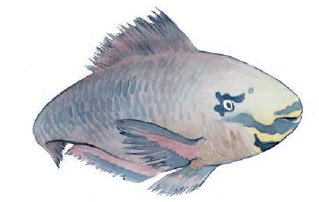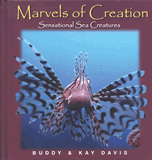
There are over 350 named species of parrotfish ranging in size from 1 to 6 feet (30 cm–1.8 m), with a few recorded as long as 12 feet (3.7 m). These beautifully colored fish live around the tropical reefs of the world.
The parrotfish are named because their teeth are joined in the front of their mouth to form a parrot beak. This beak is used to bite off pieces of coral, which is part of their diet. They also munch on eelgrass and seaweed. The parrotfish grind the coral using flattened teeth in the throat. Undigested coral is passed out and dropped in special places accumulating into heaps. It is said that you can actually hear the crunching if you are swimming nearby the parrotfish.
Depending on the species, parrotfish can live either solitary lives or join a small group. Some species live in large groups of up to 40 when feeding like herds of cattle (which resulted in the nickname, cattle of the sea). The schools are made up of fish about the same size.
There is a great variety of colors among the species and also among some males and females of the same species. Their colors include blue-green, orange and blue, and brown and white.
The parrotfish spends the night under rock ledges or in caves. If alarmed during the day, they will swim to their nighttime cover. There are some species of parrotfish that cover themselves with mucus or slime every night. This process creates a cover for the fish with an opening in the front for water to enter in and an opening in the back to let it out. It is like being enclosed in a plastic bag. When resting, the breathing rate of the parrotfish drops to a low rate. It takes up to 1/2 hour to cover itself and it takes that long in the mornings to break out. It is not known exactly what the cover is used for. A couple of theories include using the covering as protection from enemies or the covering may prevent dirt and silt from entering the gills of the fish while it rests on the sandy bottom.
The female and male release a cloud of eggs and milt near the surface of the water. Each egg contains an oil drop to keep it near the surface of the water. They hatch in one day, releasing the fish larvae.
Scientists are concerned that the parrotfish may be killing the coral reef.
Parrotfish
Perciformes • Scaridae • Scarus caeruleus
Length: Average from 1–6 feet (30 cm–1.8 m)
Weight: 4 pounds (1.8 kg)
Life Span: Unknown
Special Design Feature: The parrotfish have teeth
that are similar to a parrot’s beak.
Did You Know? The parrotfish wraps itself in a
covering of mucus every night while it sleeps.

Marvels of Creation: Sensational Sea Creatures
Brings the world of the sea alive in a unique and colorful way with photographs, a page of facts and commentaries.
Browse Kids BookRecommended Resources
- © 2025 Answers in Genesis
- Privacy Policy
- Contact
- About


